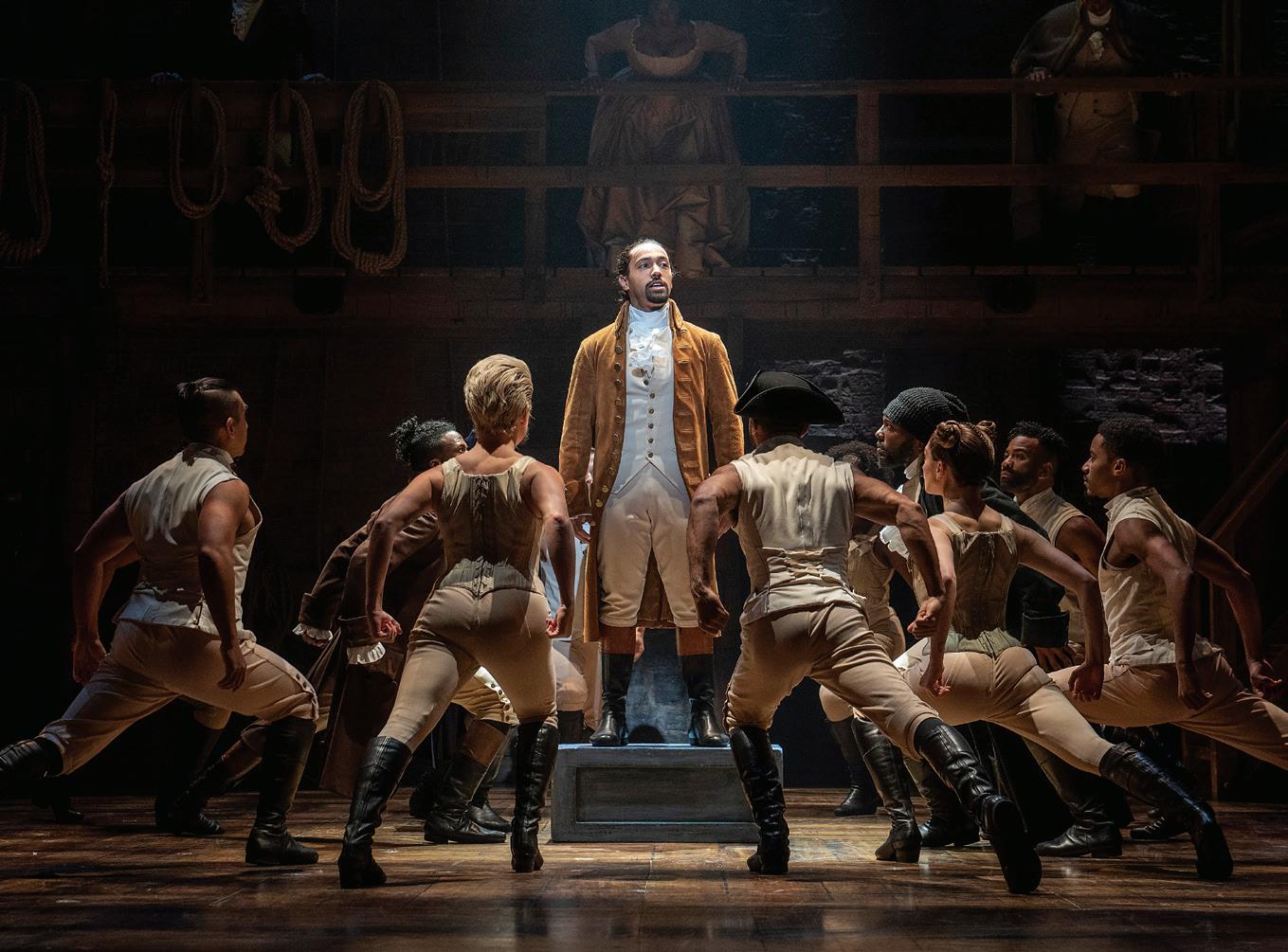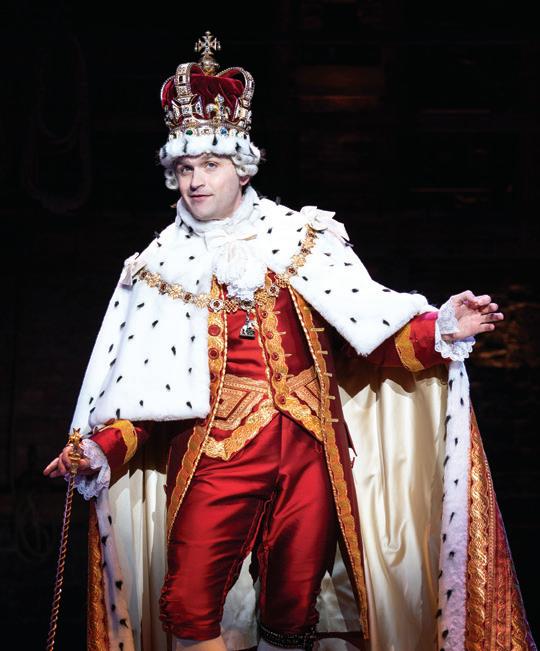
8 minute read
A MUSICAL HISTORY Behind the scenes of


THEATER
A Musical History
Director Tiffany Nichole Greene discusses the cultural impact of Hamilton: An American Musical.
THIS DECEMBER, PLAYHOUSE SQUARE welcomes the iconic Hamilton: An American Musical to KeyBank State Theatre.
The musical gained unrelenting viral traction following its release in 2015 and displays the iconic lives of historical figure Alexander Hamilton and his contemporaries. The musical exposes flaws and celebrates victories and trials, all while entertaining and educating audiences of all ages.
Originally written for Broadway by Lin-Manuel Miranda, Hamilton is split into two acts. Part one is a musical biography recounting the founding father’s difficult beginnings and his rise to political prowess. From there, the story confronts the tumultuous beginnings of America with a boisterous mix of humor, R&B music and witty repartee.
Tiffany Nichole Greene, resident director for the musical, took a moment away from the production to explain the inner workings of the show and discuss what makes Hamilton: An American Musical a smash hit around the world.
Hamilton: An American Musical graces KeyBank State Theatre Dec. 6-Jan. 15, offering a rap-infused take on history.
Q. What makes Hamilton such a culturally important show?
A. The show really brings people to history. It informs them of history they may not know. The show teaches people without talking down to them and gives them a reason to evaluate their own perspective on the history of America — the way we talk about history brings it into a whole new light.
Q. What are some of the impacts on people who attend?
A. As humans, it's therapeutic to watch a different view of what people expect this person (Hamilton) to be. It exposes a different side of humanity. Witnessing the greatness of a historical figure while also witnessing his flaws in his everyday life is something that makes a connection to attenders — sometimes it’s the hypocrisy of America through a joke or the greatness through epic moments in a respectful way. The greatness of the complication of humanities is exposed in unique way.
Q. What sets Hamilton apart from other productions?
A. The show provides opportunities for actors of color and embraces many of the things we set aside in our usual teaching of history. It embraces how the country looks now in terms of race, especially, and how it presses forward with amazing power and grit. It’s relentless in a beautiful way.
Q. What is the production like behind the curtain?
A. People think we just show up and put on the show. That couldn’t be further from the truth. We get to the location and work six days a week. We get to the theater and work all day, managing the crew and assigning rooms. Curtain closes for a show on Sunday, we travel Monday; if that’s your day off, that’s too bad. We travel with multiple large wardrobe boxes, 100 people to every city. That includes an on-stage cast and an off-stage cast that are both working just as hard as each other. The show has sold out, been selling out, so I expect it will in Cleveland, as well.

FILM
Making Noise
White Noise, out this month on Netflix, is the latest milestone in Cleveland’s ever-growing film industry.
Late last July, actors Greta Gerwig and Adam Driver mill around outside Addie’s Antiques in Wellington, 45 minutes southwest of Cleveland. Chatting off camera, Gerwig sports a frizzy mop of hairsprayed curls, and Driver hides a paunch under a plaid dress shirt. Most businesses neighboring Addie’s, an actual functioning antique shop, have been transformed into brightly colored restaurants, nightclubs and other fictional storefronts. Sitting in lawn chairs next to paparazzi, locals gawk at the spectacle as if watching an Independence Day parade, and some even get in on the action as extras on this Hollywood film set.
The meta ‘80s fever dream is the brainchild of director Noah Baumbach for his upcoming film, White Noise. But Hollywood descending upon Northeast Ohio is becoming a common scene. Fast and the Furious and Captain America: Winter Soldier shot scenes in and around Downtown Cleveland, and White Boy Rick and Cherry, directed by Cleveland natives John and Joe Russo, filmed almost entirely in the area. Heck, this is even the second film to hit Wellington, a town of just more than 4,000, which hosted Liam Neeson’s film The Minuteman in 2019.
But White Noise is different. Author Don DeLillo’s timely, anxiety-riddled ‘80s novel was deemed by some in the industry as “unadaptable” after a few false starts in the early 2000s. The book’s overwhelming feeling of existential dread, strong internal dialogue and unseen threat probably abetted that narrative. But doing it right, according to Baumbach, was enough to give most money men a different kind of dread.
Local crew members describe a spare-no-expense approach that included shutting down a stretch of highway for six weeks, transforming an abandoned Walmart into a film stage, building a faux motel under the Inner Belt Bridge in the Flats, digging a river in rural Ohio and spinning dozens of rolls of real, tactile film.
And that’s exactly what Netflix did. Bill Garvey, president of the Greater Cleveland Film Commission, estimates White Noise spent more than $100 million in Northeast Ohio — the most of any movie to date. Netflix’s original budget was about $82 million, but an extended shoot and an artist-first philosophy drove that up to a rumored $140 million, though official audits won’t come out until next year.
Production designer Jess Gonchor, who won an Academy Award for True Grit in 2010, is a master of building universes. This project called for Netflix's White Noise spent more money in a true-to-life MidCleveland than any western setting, movie before it. one with spacious supermarkets, a boy scout camp, a college campus and housing stock that looked like Anywhere, USA. Only one place came to mind: Northeast Ohio.
Tasked with setting the scene for DeLillo’s novel, which follows a professor and his family as they react to an airborne


toxic event in a “Middle America” college town, Gonchor first explored upstate New York, near Buffalo. Around the time that fell through, Gonchor found an interview where DeLillo mentioned being inspired by a supermarket in Chagrin Falls.
Gonchor never found that supermarket, but two hours west of Buffalo, he did find the perfect location to recreate the book’s fictional town of Blacksmith. In the classrooms of the University of Akron, he saw Jack Gladney’s lecture hall. Wellington and Oberlin perfectly played the cozy town surrounding “College-onthe-Hill.” Peninsula’s Camp Manitoc had a dusty sheen of reality perfect for the boy scout camp to which the Gladney family would eventually escape.
Still, Gonchor admits the deciding factor typically comes down to budget and logistical ease.
The Ohio Motion Picture Tax Credit incentives were created in 2009 to encourage studios to make movies, shows, video games, theatrical productions and more in the state. For those spending more than $300,000, Ohio offers a refundable tax credit of 30% on production cast and crew wages and other in-state spending.
But Ohio caps these incentives at a combined $40 million per year. That means if (the fictional) LeBron James on Ice eats up $20 million in tax credits, the studio behind The Wild Adventures of Cleveland Magazine Editor Dillon Stewart (in the very early stages of pre-production) only has the remaining $20 million with which to play.
Meanwhile, states such as New Mexico and Louisiana have used a $100 million cap to become leaders in the film industry, and Georgia pulled in $4.4 billion in fiscal year 2022 by not having any cap at all.
Opponents call these credits a bad deal for taxpayers. They say these filmmakers would work here anyway. But Garvey points to ripples like the 36,000 nights spent in local hotels by White Noise crewmembers. The NFL Draft, meanwhile, saw an 85% hotel occupancy rate among 26 hotels for one weekend — a number closer to 10,000 nights. A study by consulting firm Olsberg SPI found, from 2010-2020, a $3.09 return for every dollar in tax credits and that 134 projects created 6,192 fulltime equivalent jobs and $1.1 billion in total gross economic output. Meanwhile, more than $200 million was turned away due to the tax incentive cap, Garvey says.
“The opportunities have grown exponentially over the past few years, but it’s not at its peak,” says Evan Prunty, co-founder of Black Valve Media who served as a video playback operator on White Noise. Throughout DeLillo’s novel, television clips puncture real life with snippets of consumer culture, creating a uniquely modern state of anxiety. Prunty worked to recreate that motif with the television sets and other circa-1980s props you see throughout the film.
As a member of the Local 209 union, which represents entertainment industry members in Ohio and Northern Kentucky, Prunty is on a list of local crewmembers that studios can tap when making films. He pays $1,500 in dues, which he says “pays off tenfold.”
Studios actually prefer to use local talent, Gonchor says. It’s cheaper. But it’s not always possible.
The movie is an adaptation of Don DeLillo's satirical, campus-set '80s novel.











